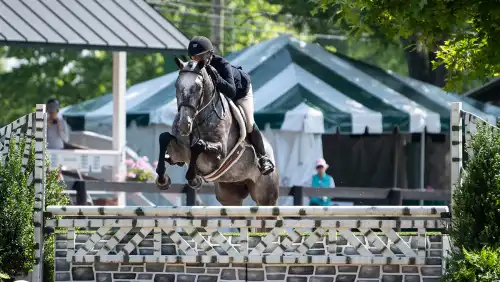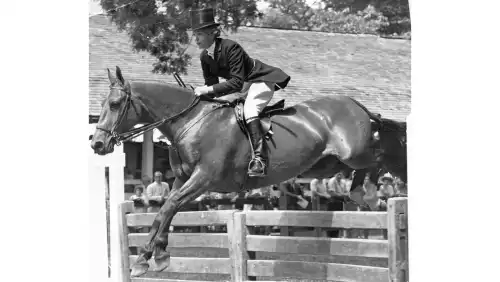Amateur rider Tiffany Elmer has been blogging for the Chronicle about her preparation for a George H. Morris clinic. Her account of Days 1 and 2 of the clinic is here: “Day 1 Of Learning From The Most Famous Perfectionist, George H. Morris,” and here is Day 3’s account.
As the days progressed, so did the complexity of our coursework. Day 3 of the George H. Morris clinic was a lot of changing in strides and bending lines and straight lines with angled jumps.
George asked for the counter-canter quite a bit during our flatwork and mentioned that he spends “50 percent of his time in counter-canter.” I thought I had schooled this quite a bit, but after he said this I realized how wrong I was!
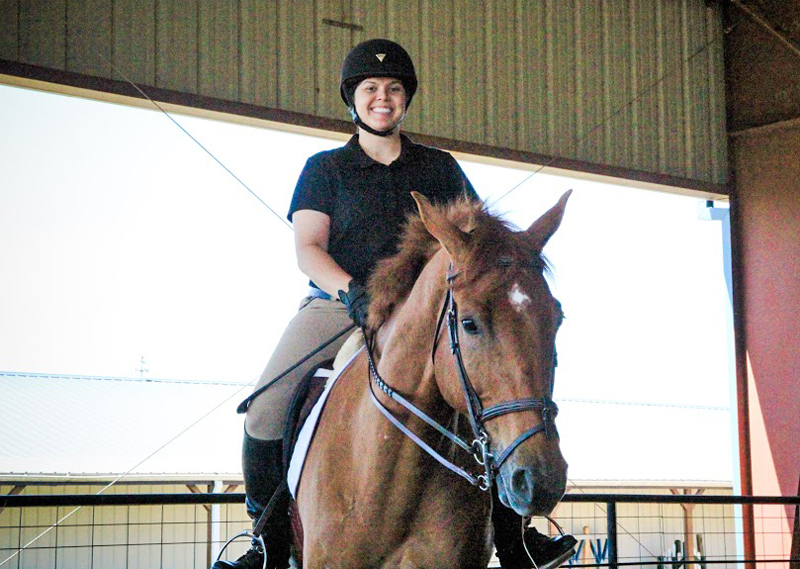
Capone and I in the clinic.
We spent some time working on lead changes with George. He prefers for lead changes to be in a full seat as horses need to learn to accept the aid of your seat. Any step alteration is a resistance to either the seat or new inside leg and to be corrected with spur or stick. Horses that get light or hoppy in the back end are backward, and you should correct with leg, spur, or stick.
If a horse doesn’t completely change, the discipline is to spur or stick on the new inside leg. If a horse is a late with a change, correct with haunches-in and shoulders-out. The reward for a horse is simply a lack of discipline or a release of pressure. No one disciplined enough, “Stop the petting. Petting, petting, petting. It’s not called petting, its called riding!”
I should have schooled lead changes more before this. Capone is great with his lead changes, except when asked. He prefers to get them on his own, but when asked he’s one of the horses that resist by getting light in the hind. After seeing some other people get berated I was ready with my stick and got an acknowledgment from George, “Now that’s a horse trainer!” Which I immediately smiled at and then tried to hide, because “you do not laugh at this sport!”

George giving me some tips.
We progressed from lead changes to going down an outside line (three strides to three strides), half turn, lead change, and repeat. During one girl’s turn, George got distracted elaborating on this exercise to the auditors. She went so many times I thought she was going to pass out before he finally excused her.
Capone did awesome during the exercise because he could do the changes on his own. Capone is one of those rare unicorns of horses who likes to get his changes on a straightaway prior to a turn. So we got quite a bit of beautiful change/beautiful straight line/beautiful straight change—or should I say Capone got quite a bit of those? But still, its music to the ears!
Day 3 had some complicated course work and nothing is more terrifying than silence while on course in a GHM clinic. Was he watching? Was it literally too bad for words? The silence went on for a good six fences (what felt like an eternity) before Capone refused the liverpool mid-course and he was quick to yell “Stick him! Spur him! Do something with your life!” (A quote which my husband likes to tell me now with a chuckle.)
Day 3’s course:
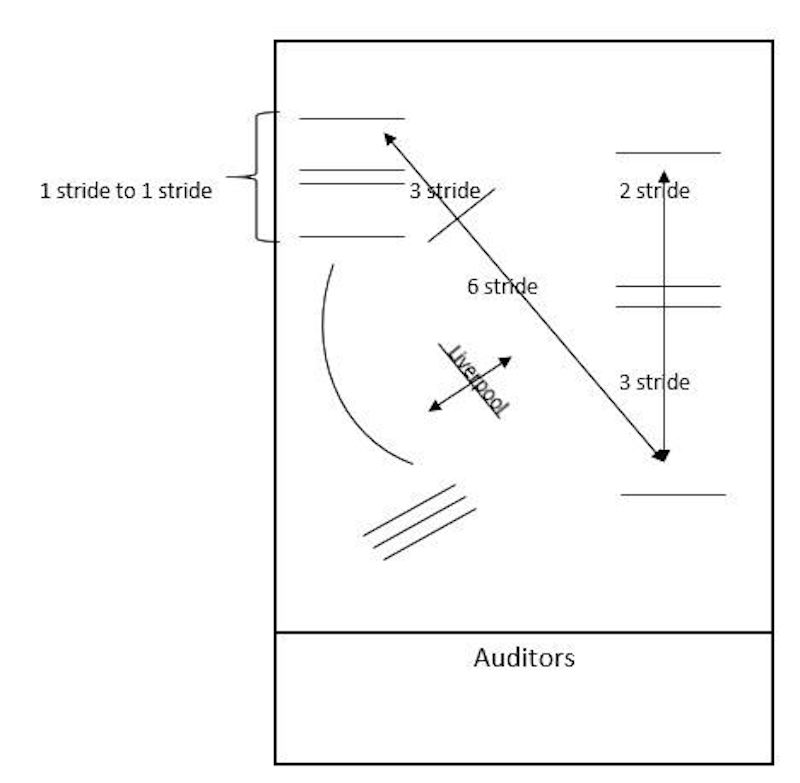
After three days of refusals, George finally had me address the fence and stick him a couple times behind the leg. He isn’t a fan of addressing fences, because horses should be taught to jump whatever they are pointed at—not stopped and disciplined. He made us jump it a few times, turning in the opposite direction of where Capone tried to run out, before having us continue on course.
Here are some of the big things I took away from GHM:
ADVERTISEMENT
- Angled fences—people don’t work on taking fences at an angle for a straight line enough.
- If the striding is a perfect four strides, do it in three or five—don’t be satisfied with the good stride. When coursing or schooling his students he always has them do the add first for control, before doing the correct stride.
- Always inside leg to outside rein!
- Counter canter should be schooled 50 percent of the time. Your horse should be extremely well schooled in counter-canter.
- Lots of haunches-in/-out (great for late changes) and shoulder-in/-out.
- No-stirrup work! He always rides a horse 45-50 minutes without stirrups at least once a week.
- Full seat for lead changes—it makes the horse accept the leg, seat and bit.
- Stirrups—never aluminum! (The horror!)
- Accuracy is always better than pace or rhythm.
- Flatwork is the most important part of schooling!
- It creates a feel for impulsion, rhythm and contact that can’t be taught over fences.
- Jumping is an art because of the fence—work on your weak points!
- When riding a four-stride line, focus on pace, precision, and straightness. If even one of these components is missing then add for a five-stride.
And finally we get to the last part, but this is perhaps the most important in George’s eyes. DIET AND EXERCISE! For three days he didn’t fail to start the day off with a lecture on the need for diet and exercise. As one of the heavier riders it was hard not to feel like he is singling you out, even though he is addressing the group. “You have to be fit for this sport! You have to be strong enough!” He never individually addressed a rider’s weight, unless they were unable to perform the exercise or keep up. And then he would berate them on their fitness.
If you are heavier, I recommend being as fit as you can before riding with George (no-stirrup work). It definitely paid off for me and he didn’t mention my weight since I was able to keep up. But I guarantee you, had I lagged behind or pulled out of an exercise, it would have been his first criticism.
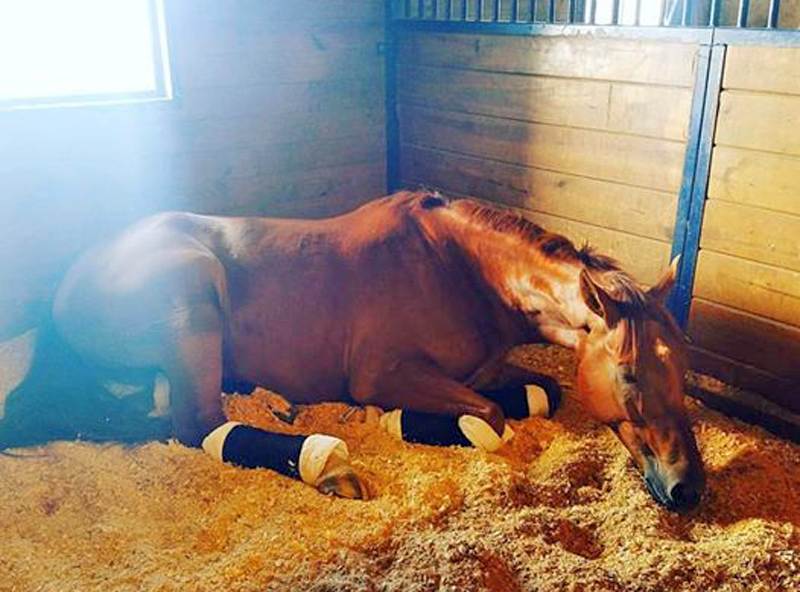
Capone was ready for a nap after our sessions!
George explained that he liked spreading basic classical knowledge across the country, which is why he teaches so many clinics. He cautioned parents and trainers that we need to school our children in the word “no.” Riding is a dangerous sport and often we see youth skipping steps and parents or trainers letting them. None of his students decide what divisions they want to show in, they know better! He tells them what they will show in. When schooling, students should be challenged slightly above their comfort level, on a scale of 1 to 10 around a 7.
“Riders have to have ambition! Goals! There must be a drive to want to be better!” George said. Which is what this whole experience was about for me—the drive to be better than I am. I couldn’t have done it without some amazing individuals along the way. First and foremost, my husband, Kevin. He groomed, mucked out stalls, hand grazed, filled hay nets, watered, AND was George’s legger-upper for three days. Thank you so much for supporting me and this crazy sport I love.
Lindsay Banks was literally the best clinic hostess I have ever had! We had clinic favors (liniment), monogrammed saddle pads (GHM clinic 2017), and a wonderful lunch all three days. Although George did mention we shouldn’t have been provided cookies! “That is the problem!”
My trainer, Krissan Barber, who is a flatwork enthusiast and perfectionist herself. I wouldn’t have been half as prepared for this clinic without you. If I felt any over-confidence going into this clinic it was because of your rigorous training program. Capone didn’t even break a sweat!
Special thanks to my fellow Blackjack riders who rode as well. Everyone helped each other in little ways. Thanks to the other riders in the clinics, many of whom I have since become friends with. It’s fun seeing everyone spreading the knowledge we learned from GHM. I hope to see you again at future clinics! Until then I will keep practicing and having the occasional dream of George yelling at me, “Stick him! Stick him! Get back over here and do it again!”

Such a great experience!
I have included some GHM quotes from the clinic for your reading pleasure:
“Don’t forget leg, even if you are going backwards—FORWARD!”
“Competition is a dangerous thing—it breeds exaggeration. It’s bad for the hunters who over-lunge, medicate, and practice repetition. It’s good for raising the bar and drive!”
“I love a good cluck!”
“Horses are not made of glass—SPUR!”
“I hate these stirrup irons!” (referring to aluminum stirrups)
ADVERTISEMENT
“You’re one of those up and down, desperate housewives!”
“You people have no discipline!”
“I can’t teach you people if you don’t listen!”
“You people are half stupid.”
“What are you doing on a jumping horse without a stick? People don’t go to war without a gun!”
“Practice your GUTS! If in doubt be over aggressive.”
“If a horse has three minutes, we have four. We always have more time than the horse.”
“Don’t be afraid of contact, people don’t put a spur on them!”
“Don’t do that with a whip in your hand, it looks like self-flagellation!” in reference to petting.
“Your husband could tell you a thing or two about how you’re a control freak.”
Tiffany Elmer, 30 and from Texas, balances her work as a teacher with riding her homebred horse, Capone. She’s been riding since she was 11—through high school, college, dating, marriage and her career—and has competed in the hunters, equitation, jumpers and a bit of eventing. Capone is her “forever” horse. “I bred for a paint eventer mare, and got a lovely chestnut hunter gelding!” she said. “We currently are working on cleaning up our 3’6” hunter rounds with an end goal of international derbies.” Tiffany’s current goal is a George H. Morris clinic in May.
“Capone’s favorite hobbies include asphyxiation—he likes to roll his tongue, put his head in the air, and suck on it. I always have to leave a sign up at shows or people will call me thinking he’s choking (weird, right?). And he also likes to torment the elderly gentleman in the gelding pasture,” Elmer said. Read all of Tiffany’s COTH blogs.







